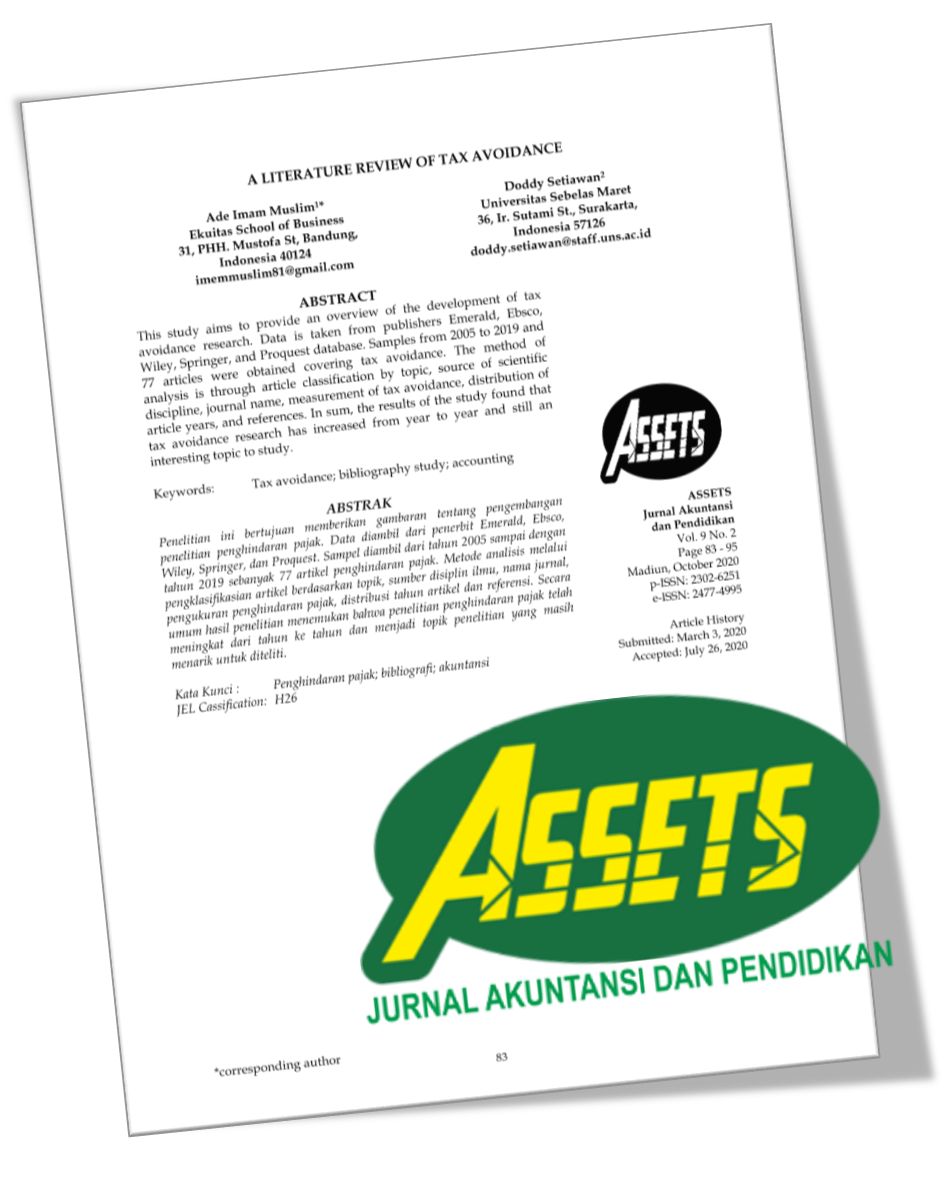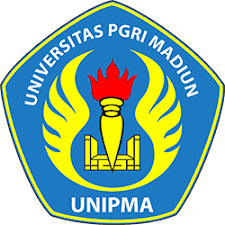OPTIMIZATION OF PROBLEM-SOLVING SKILLS THROUGH THE APPLICATION OF CREATIVE PROBLEM-SOLVING MODELS ASSISTED BY ACCOUNTING CARDS
Abstract
ABSTRACT
According to the national education paradigm of the 21st century, the goal of accounting learning emphasizes the ownership of skills needed in the 21st century, including problem-solving skills. The Creative Problem Solving (CPS) learning model was chosen to improve learners' ability to solve a problem with structured steps so that learners will be accustomed to honing problem-solving skills. This is a classroom action research carried out in two cycles: planning, action, observation, and reflection. The research subjects were 33 students of class X Accounting 3 SMK N 3 Surakarta. The data collection techniques are tests, observations, interviews, and documentation. Techniques for testing the validity of data using source triangulation. The results showed an increase in problem-solving ability from the medium category in first cycle to the high category in second cycle.
ABSTRAK
Tujuan pembelajaran akuntansi menurut paradigma pendidikan nasional abad 21 menekankan pada kepemilikan keterampilan yang dibutuhkan pada abad 21, diantaranya kemampuan memecahkan masalah. Model pembelajaran Creative Problem Solving (CPS) dipilih untuk meningkatkan kemampuan peserta didik dalam menyelesaikan suatu masalah dengan langkah-langkah yang terstruktur, sehingga peserta didik akan terbiasa untuk mengasah keterampilan pemecahan masalah. Penelitian ini merupakan penelitian tindakan kelas (PTK) yang dilaksanakan dua siklus dengan tiap siklus terdiri dari perencanaan, tindakan, observasi dan refleksi. Subjek penelitian adalah 33 peserta didik kelas X Akuntansi 3 SMK N 3 Surakarta. Teknik pengumpulan data yang digunakan adalah tes, observasi, wawancara dan dokumentasi. Teknik untuk menguji keabsahan data menggunakan triangulasi sumber. Hasil penelitian menunjukkan terdapat peningkatan kemampuan pemecahan masalah dari kategori sedang pada siklus pertama meningkat menjadi kategori tinggi pada siklus kedua.
Keywords
Full Text:
PDFReferences
Al Mallak, M. A., Tan, L. M., & Laswad, F. (2020). Generic skills in accounting education in Saudi Arabia: students' perceptions. Asian Review of Accounting.
Anggarini, D., Veronica, & B.R., Kartono,K (2015). Keefektifan Pembelajaran Core Berbantuan Kartu Kerja Pada Pencapaian Kemampuan Masalah Matematika dan Kepercayaan Diri Peserta didik Kelas VIII. Unnes Journal of Mathematics Education, 4 (2) , 1-9.
Anisah,Hanna., & Mawaddah, Siti. (2015). Kemampuan Pemecahan Masalah Matematis Siswa Pada Pembelajaran Matematika Dengan Menggunakan Model Pembelajaran Generative (Generative Learning) di SMP, Jurnal Pendidikan Matematika, 3 (2). (166-175). Diperoleh 10 Januari 2020, dari https://ppjp.ulm.ac.id/journal/index.php/edumat/article/view/644/0
As-Salam et al. (2018). Peningkatan Kemampuan Pemecahan Masalah Matematis Peserta didik Dengan Menggunakan Model Pembelajaran Creative Problem Solving Pada Materi SPLDV di kelas VII SMP Negeri 2 Takengon. Jurnal As-Salam, 2 (2),22-32.
Astina, Komeng Utaya, Sugeng & Setiawan F A (2019). The Effect of Creative Problem Solving Learning Models with Synectics Techniques Toward Student Creative Thinking Ability. International Journal of Recent Technology and Engineering (IJRTE).7.715-720
Hariani, P. P. (2019, November). Difference of Accounting Learning Results Using Model Creative Problem Solving Learning and Modelling The Way At Students Faculty of Teacher Training and Education. In Profunedu International Conference Proceeding (2). 89-91
Hu, R., Xiaohui, S., & Shieh, C. J. (2017). A study on the application of creative problem solving teaching to statistics teaching. Eurasia Journal of Mathematics, Science and Technology Education, 13(7), 3139-3149.
Lewis, P. A., Knoblich, G., & Poe, G. (2018). How memory replay in sleep boosts creative problem-solving. Trends in cognitive sciences, 22(6), 491-503.
Pepkin L Karen. (Eds). (2014). Creative Problem Solving in Math. Houston Teachers Institute. (p.1-14). Texas: University of Houston
Polya G. (1973) How to Solve it (A New Aspect of Mathematical Education). (Second Edition). New York: Doubleday & Company, Inc.
Sabban & Hayyun (2018) Peningkatan Kemampuan Pemecahan Masalah Matematika Dengan Model Pembelajaran Creative Problem Solving (CPS) Pada Peserta didik Kelas VIII A SMPN 1 Ciruas. E- Jurnal Mitra Pendidikan, 2 (10), 1078-1088,
Sagita, I., Medriati, R., & Purwanto, A. (2018). Penerapan Creative Problem Solving Model Untuk Meningkatkan Kemampuan Pemecahan Masalah Fisika Siswa Kelas XI MIA 4 MAN 2 Kota Bengkulu. Jurnal Kumparan Fisika, 1(3 Desember), 1-6.
Sari, D. M., Ikhsan, M., & Abidin, Z. (2018). The development of learning instruments using the creative problem-solving learning model to improve students' creative thinking skills in mathematics. In Journal of Physics: Conference Series, 1088, 012018
Singh, O. (2018). Role of Teachers in 21th Century: Opportunities and Challenges. International Journal of Scientific Research and Review, 7(5), 1-7.
Syariffudin, Hendra., & Sisriwati, Y.Y. (2019). The validity of learning Devices with Creative Problem Solving Models to Improve Mathematical Problem-Solving Ability. International Journals of Science and High Technologies ,13 (1), 67-73.
Treffinger, D. J., Isaksen, S. G., & Stead-Dorval, K. B. (2006). Creative problem solving: An introduction. Prufrock Press Inc..
Murwaningsih, T., & Fauziah, M. (2022). The effectiveness of the TASC, CPS, and DI on divergent thinking skill at elementary school in Indonesia. International Journal of Instruction, 15(1), 167-184. https://doi.org/10.29333/iji.2022.15110a
Udiyah., & Pudjiastutik. (Ed). (2017). Penerapan Model Pembelajaran Creative Problem Solving (CPS) terhadap Kemampuan Pemecahan Masalah IPA Kelas VII SMP Negeri 2 Tuban. Proceeding Biology Education Conference, hlm 540-544. Surakarta: FKIP Universitas Sebelas Maret
Utami, C., Citroresmi Prihatiningtyas, N., Rosmaiyadi, R., Husna, N., Wahyuni, R., & Mursidi, A. (2021, April). Ability of Problem Solving and Critical Thinking of Students in Learning of Creative Problem Solving (CPS). In 2021 The 6th International Conference on Information and Education Innovations (pp. 99-103).
van Hooijdonk, M., Mainhard, T., Kroesbergen, E. H., & van Tartwijk, J. (2020). Creative problem solving in primary education: Exploring the role of fact finding, problem finding, and solution finding across tasks. Thinking Skills and Creativity, 37, 100665.
Wieth MB, Francis AP and Christopher AN (2019) Use of a Creative Problem Solving (CPS) Approach in a Senior Thesis Course to Advance Undergraduate Publications. Front. Psychol.
Zubaidah (2017). Pembelajaran Kontekstual Berbasis Pemecahan Masalah Untuk Mengembangkan Kemampuan Berpikir Kritis. Prosiding Seminar Nasional Pendidikan Biologi Berwawasan Konservasi dalam Mewujudkan Sumber Daya Manuia yang Berkarakter. Hlm. 1-17. Makassar: FKIP Universitas Muhammadiyah Makassar.
Article Metrics
Abstract has been read : 643 timesPDF file viewed/downloaded: 0 times
DOI: http://doi.org/10.25273/jap.v11i1.7213
Refbacks
- There are currently no refbacks.
Copyright (c) 2022 Sri Sumaryati; Muhtar Muhtar; Rizky Yuniar Sururi

This work is licensed under a Creative Commons Attribution-NonCommercial-ShareAlike 4.0 International License.
ASSETS: Jurnal Akuntansi dan Pendidikan is supported by
ASSETS: Jurnal Akuntansi dan Pendidikan is indexed by
| | | ||||
| | | | |

ASSETS: Jurnal Akuntansi dan Pendidikan is licensed under a Creative Commons Attribution-ShareAlike 4.0 International License.











